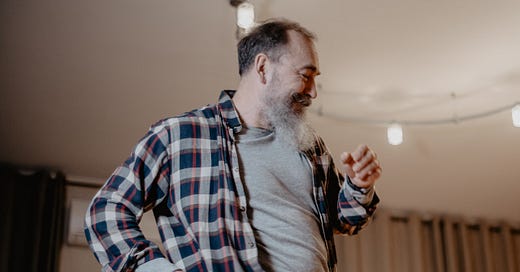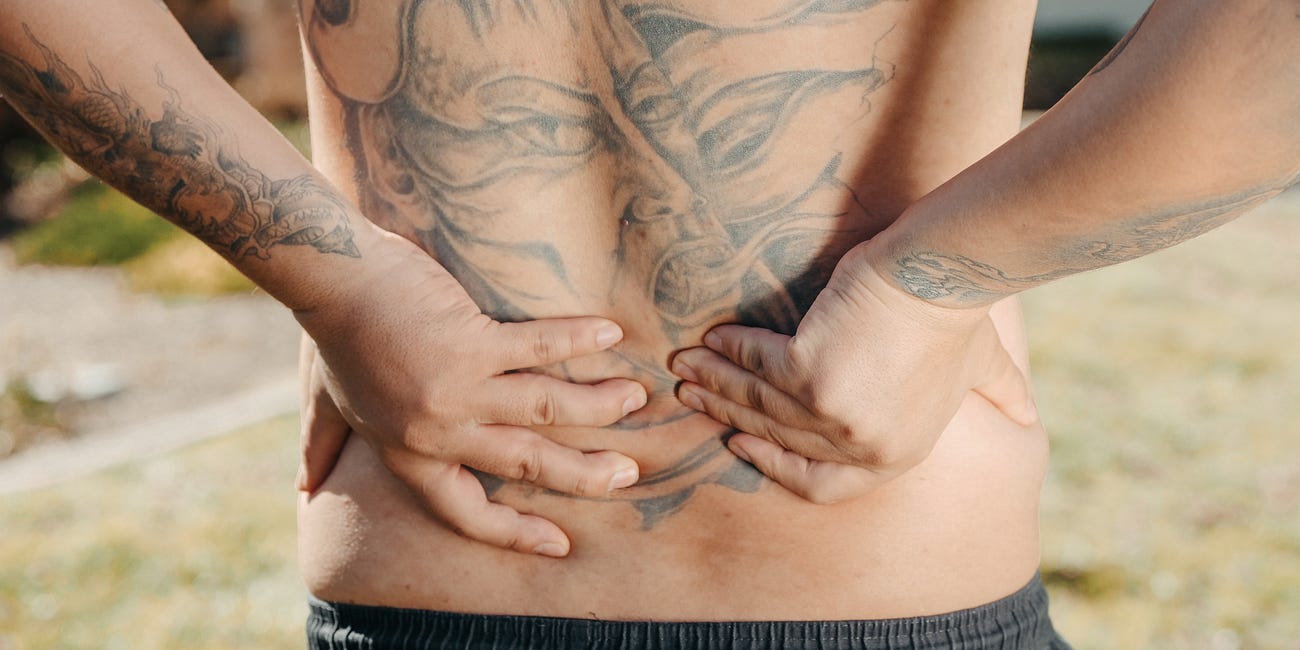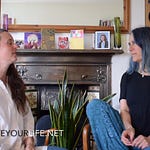Londoners! You are warmly invited to an
In-Person Soundbath
this Friday 14th at 7:30pm in Crouch End
For full details and booking scroll to the end of the article.
Dear Reader,
In this week’s article, I’d like to take a deep dive into body movement. So get up from your desk, bed, chair whatever and have a delicious full-body stretch!! Feel better?? Of course you do! And if you just sneakily skipped that little task then I hope what you read here will inspire you to have a move and a stretch when you’re done reading or even as you’re listening.
Exploring movement is what I do most of my days, so I thought I’d share a summary of what I’ve learned over the years. If you’ve ever wondered what the purpose of stretching is, what is the difference between tensing a muscle and engaging a muscle, or if you simply wonder how moving attentively can bring about such profound change in your mind, even in your spirit, your soul, then this series of articles is for you!
The series I’m planning is in three parts. Part 1: Wonder of Movement; Part 2 Wonder of Asana; Part 3 Wonder of Somatic Movement. Although I love writing about yoga philosophy so much, movement is what I live, breathe and teach, most days… It’s what brought me to yoga and it is what keeps me here exploring and enquiring, researching and discovering. This is my ultimate favourite topic and I have so much to share with you… so let’s begin.
Movement increases the detail in the internal maps that our brain holds of the body. These are in the sensory cortex (the feeling map) and the motor cortex (the movement map). All conscious movement, in which our focus is on the feeling of the body movement and not elsewhere, adds to the richness of this detail. However, autopilot movement - e.g. jogging whilst watching telly in the gym, dancing while inebriated and walking home whilst texting on your mobile phone is not going to have such a beneficial effect. Most exercise and even cleaning or gardening will have this beneficial effect if you are mindful of your movements. Creating and maintaining clear, bright neurological pathways to these brain structures helps you to prevent falls, improve your balance, increase your confidence and alleviate joint pain. It is important for us all to have a movement practice, particularly if we have a sedentary job or lifestyle.
There are two types of movement that I specialise in, yoga and somatics. There are overlaps between yoga and somatics and there are differences. Learning somatics helped me to understand how yoga asana worked, and why it didn’t work so well for certain purposes. This doesn’t mean to say that one type of movement is better than the other. They are highly complementary. But in this article, we’re having a look at general day-to-day movement.
When we move, we feed the sensory and motor cortexes of the brain with more experiences. Yes, I intentionally didn’t use the word data or information - experience is more embodied, juicy and rich than mere 0s and 1s. In this new age of AI, it is important for us to really understand this… The AI technology is not embodied, it doesn’t feel itself, it simulates our feelings, it doesn’t “have” feelings. As such, AIs don’t sense things, they only process 0s and 1s very very fast and give the impression that they sense things. Also (one would hope) they can be turned off, that is without dying. They are not alive. Let’s not give the AI too much power. Yes, let’s stop pause and think about the ramificationsof AI but let’s not glorify it. I’d say Chat GPT gets the answers to the questions I ask wrong around 50% of the time. It’s doesn’t seem to be that bright. Yet, I digress… Feeding our sensory cortex and motor cortex embodied movement experiences, enables us to find more nuance, detail and balance in our movement. This matters, particularly as we age.
When I speak of balance, I don’t mean symmetry. We are not robots, we’re humans! As such we are inherently asymmetrical. Our brain's right and left hemispheres are asymmetrical, and our organs' shape, size and arrangement are asymmetrical. Indeed, the way we live our lives isn’t symmetrical. We have a dominant hand, and a preferred foot, which we use more often. This has implications all the way up through our combined myofascial and skeletal systems. We have quirks and twists and turns in the structures of our tissues which are totally unique for each individual human. It is also true that most humans have more sensory-motor communication to the right-hand side of the body (even in left-handed people) than the left-hand side.
In addition, we have asymmetrical patterns of tension that we learned from our carers, others that we developed in response to trauma, and other patterns that are simply habits we developed in response to demands of our work or other life pressures. To expect to iron all this out and become perfectly symmetrical or perfectly balanced is ill-advised. Trust me, I know from experience this path will only lead to self-judgement and sorrow.
A healthier approach is to simply get to know our unique quirks really well. Play with them, dance with them, move and breathe around, through and with them. Most of all - love these rebellious parts of yourself, the parts that don’t fit in, the parts that feel a bit cranky. They weave your personal story within the fabric of your fascia. These ill-fitting, grumbling, misbehaving parts of you tell of the injuries, experiences, operations, dramas, shocks, the highs and lows of your life. Be kind to them. These areas are like little children who’ve had a bad day (or bad few years) at school. They need your attention, love and care. Each little quirk is fabulous and makes you recognisable as you.
So don’t feel the need to fix these parts that seem broken, but do celebrate when your body and mind find a way to unlock some held tension. When this happens as it does regularly with a movement practice, dwell in the delight, of realising that your body has become a little more free and aligned around your centre of gravity. That your being has found a little more comfort and ease in theisworld. All the while knowing that your panchamayakosha (the five perceivable layers of your being in this manifest reality - prakriti) are a constantly changing work of art. A fascinating sculpture in the making, being continually shaped by life until the day you move beyond this earthly plane.
Our fascial net is indeed a little like a kind of clay, which happens to contain muscles, organs, glands and blood vessels. We shape the clay by carrying bags and children; by activating emotional holding patterns in response to life stressors; moving, sitting and standing or being still. Everything we do, think, experience, even the way we breathe, the way we walk… it is all written in our fascial net.
Working with myofascial tension patterns, which are the expression of samskara (our physical, mental and emotional imprints) in the annamayakosha (our physical body) is an ongoing process. We build up tension, and lay down fascial tissue to hold ourselves more firmly in our desk posture; our driving the car posture; our cooking posture; our washing-up posture; our carrying the shopping posture; our watching the telly posture… The limited range of motion that society deems to be acceptable for us to move within keeps us in a kind of prison.
Yoga, somatics, dance, martial arts, sports and rewilding ourselves are ways we can break free of this bodily incarceration. The aches and pains we feel accordingly are actually a very sophisticated bio-feedback system. I discuss the teachings of pain in the three-part series called “Attending to the Messages of Pain,” See Part 1 below.
Attending to the Messages of Pain: Part 1
Listen now (10 min) | Pain in the Body - Pain in the Mind I could write volumes on pain. It is a mysterious and multilayered subject. The reason is that pain is not merely the output of the body but also the mind. In fact, (as many people are starting to recognise) it makes little practical sense to separate the body and mind, they are interwoven an…
Movement truly is medicine.
As we move, our layers of muscle and fascia slide and glide against each other. This movement melts away the fuzz of fascial layering that helps us hold our “chair-shaped posture” for long hours, but that also creates a feeling of stiffness and rigidity. Movement also creates and distributes a special type of bio-organic lubrication fluid in our joints called synovial fluid.
Movement is particularly important for maintaining our immune function as it is the main driver of lymph flow. The contraction of skeletal muscles and the pulsations of the arteries move this incredible cleaning fluid around our body through various biological filters called lymph nodes. Lymph contains, lymphocytes (white blood cells) and other immune cells that monitor and then destroy pathogenic bacteria, viruses, parasites and fungi. It’s like an internal disinfection and cleaning system that washes through our tissues, taking the resulting waste to our bloodstream to be recycled.
To enable our lymphatic system to work optimally, we need to move! The lymphatic system particularly appreciates it when we have our legs above our head and also thrives when we balance on one foot, activating strong muscular contractions in our lower legs and feet. Such movements literally support the carriage of the fluid towards our heart, taking all the body’s “dirty dishwater” to be cleaned and recycled in the bloodstream.
There are many other ways in which movement supports our well-being and health. One of the aspects I love about yoga is that we can tailor-make holistic practices for the individual’s specific and unique needs. In addition, yoga’s curative powers go beyond the physical into the realms of mental, emotional and spiritual well-being. This is a vast topic (which is why my Yoga Therapy Diploma takes around three years to complete). However the week after next, we’ll take a peek at how the specific movements of yoga asana work to support us. Next week will be a shorter post as I’ll be busy in the lead-up to the next module of the Diploma.
I hope I’ve inspired you to move out of society’s ordinary movement repertoire today. Movement truly enables your health, freedom, independence and resilience to stress. Its gifts are many and varied… Explore unusual movements you don’t normally make, noticing how your body feels as it moves. Internally sense the engagement and release of the symphony of your muscles working harmoniously together to balance, extend, flex, twist, bend, lengthen, curl and reach. Now… it’s time for that full-body stretch!! Enjoy!
If you’d like to explore some of these ideas with me in a live class, I’d love to welcome you either in person or online. I’m teaching on Monday in Crouch End at 1:30pm and Tuesday online at 6:30pm BST, with a free meditation circle on Monday morning 8am on Zoom.
Sound Bath Crouch End
My partner Alistair would love to welcome you to a soundbath next Friday 14th July 7.30pm at Life By Margot in Crouch End, North London.
Sound is a type of movement, that is felt as vibration, all the way down to the cellular level. It is a special kind of alchemical healing that is deep-rooted and ancient and only just starting to be revived in our modern culture.
From deeply relaxing harp and singing bowl tones to the cosmic sound of symphonic gongs, come embark on your own uniquely profound inner journey.














Share this post